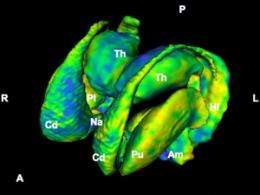Dips and Swells of Your Brain May Reveal Early Mental Disorders

(PhysOrg.com) -- John Csernansky wants to take your measurements. Not the circumference of your chest, waist and hips. No, this doctor wants to stretch a tape measure around your hippocampus, thalamus and prefrontal cortex.
OK, maybe not literally a tape measure, but he does want to chart the dimensions of the many structures in the human brain. From those measurements -- obtained from an MRI scan -- Csernansky will produce a map of the unique dips, swells and crevasses of the brains of individuals that he hopes will provide the first scientific tool for early and more definite diagnosis of mental disorders such as schizophrenia. Diagnosing the beginning stage of mental disorders remains elusive, although this when they are most treatable.
The shapes and measurements of brain structures can reveal how they function. Thus, Csernansky hopes his brain maps will reveal how the brains of humans with and without major mental disorders differ from each other and the time frame over which those differences develop.
Diagnosing psychiatric disorders currently is more art than science, said Csernansky, M.D., the chair of psychiatry and behavioral sciences at the Northwestern University Feinberg School of Medicine and of psychiatry at the Stone Institute of Psychiatry at Northwestern Memorial Hospital. Unlike a heart attack, for example, which can be identified with an EKG and a blood test for cardiac enzymes, psychiatric illness is diagnosed by asking a patient about his symptoms and history.
"That's akin to diagnosing a heart attack by asking people when their pain came and where it was located," Csernansky said. "We would like to have the same kinds of tools that every other field of medicine has."
To that end, he is heading a National Institutes of Mental Health study to measure the differences between the structure of the schizophrenic and normal brain to be able to more quickly identify schizophrenia in its early stages and see if the medications used to treat the illness halt its devastating advance.
Schizophrenia usually starts in the late teens or early 20s and affects about 1 percent of the population. If the disease is caught early and treated with the most effective antipsychotic medications and psychotherapy, the patient has the best chance for recovery.
Current treatments are evaluated on whether the patients' symptoms improve over several months. Csernansky, however, wants to take a longer and broader view.
"What we want to know is whether a few years later are you more able to work, are you better able to return to school?" he said. "If you take these medicines for years at a time, is your life better than if you had not taken them? We want to understand the effects of the medicines we give on the biological progression of the disease. We think that's what ultimately determines how well someone does."
Psychotic and mood disorders are life-long illnesses and require management throughout a person's life.
Csernansky is recruiting 100 new subjects, half with early-stage schizophrenia and half who are healthy, to map their brain topography and compare the differences and changes over two years.
"The brain is very plastic and is constantly remodeling itself. Any changes we see in a disease has to be compared in a background of normal changes of brain structures," said Csernansky, who also is the Lizzie Gilman Professor of Psychiatry and Behavioral Sciences.
He said a brain map of schizophrenia would enable doctors to make the diagnosis with more confidence as well as catch it earlier.
"Like every other illness, psychiatric illnesses don't blossom in their full form overnight. They come on gradually," he said. "You don't need a biomarker to tell you that you have breast cancer, if you can feel a tumor that is the size of a golf ball. But who wants to discover an illness that advanced? A biomarker of the schizophrenic brain structure would help us define it, especially in cases where the symptoms are mild or fleeting."
In the past, comparing MRI brain maps was done painstakingly by hand. A technician used a light pen and attempted to trace and manually measure the boundaries of structures in the brain.
"It was very laborious and you had to have an expert in your laboratory," Csernansky explained. Now he is teaching computers to do the work, speeding the process and enhancing accuracy.
Csernansky's previous research has already shown that the brains of schizophrenic patients have abnormalities in the shape and asymmetry of the hippocampus, a part of the brain that is critical to spatial learning and awareness, navigation and the memory of events.
"People with schizophrenia also have problems with interpretation, attention and controls and thought and memory. So the thalamus is another natural structure to study," said Lei Wang, assistant professor of psychiatry and behavioral sciences, and of radiology, at Northwestern's Feinberg School. Wang works with Csernansky on brain mapping.
Csernansky says, "Understanding what changes in brain structure occur very early in the course of schizophrenia and how medication may or may not affect these structures as time goes by will help us reduce the uncertainty of psychiatric diagnosis and improve the selection of treatments."
Source: Northwestern University (news : web)
















